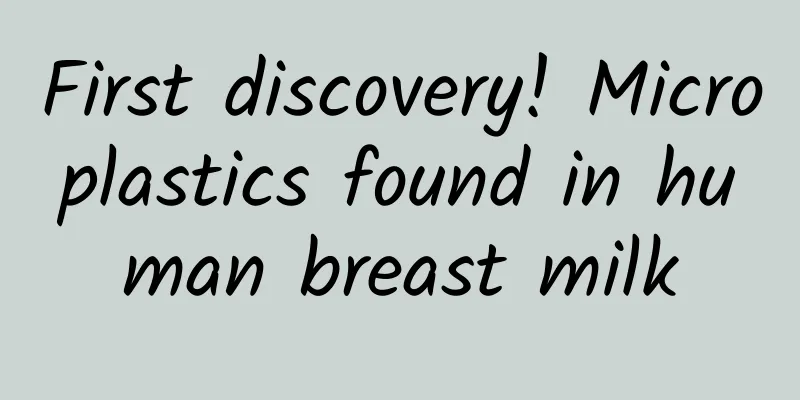First discovery! Microplastics found in human breast milk

|
Microplastics, an "invisible killer" that threatens the earth's environment and human health , are now everywhere. In previous studies, scientists have found traces of microplastics in the deep sea, the top of Mount Everest, seafood, human placenta, infant feces, etc. Once these particles with a size of less than 5 mm and non-degradable particles enter the human body, they may interfere with the human endocrine system and cause long-term effects on human health. In addition to causing direct harm to the human body, microplastics also affect the global climate - by reflecting sunlight radiation, they have a tiny cooling effect on the climate. Recently, a new study on microplastics found that microplastics have entered human breast milk and may have adverse effects on infant health. The research team said that while they are still not completely sure about the specific health effects, the findings are still worrying because infants are very vulnerable to chemical toxins and chemical exposures. The relevant research paper, titled “Raman Microspectroscopy Detection and Characterisation of Microplastics in Human Breastmilk”, has been published in the scientific journal Polymers (Basel). Since the 1950s, global plastic production has increased year by year, and more than 40% of plastics are used as disposable packaging, generating a large amount of plastic waste. Non-biodegradable plastic waste will degrade into plastic particles with a diameter of less than 5 mm due to mechanical wear and photo-oxidation. In 2004, Richard C. Thompson, a professor at the University of Plymouth in the UK, and others published an article titled “Lost at Sea: Where Is All the Plastic?” in the scientific journal Science, in which they first proposed the concept of “microplastics” and defined it as plastic fragments and particles with a diameter of less than 5 mm. In this study, the research team attempted to analyze the presence of microplastics in breast milk samples from 34 healthy mothers , all of which were collected within one week after the mothers gave birth. Surprisingly, microplastics were present in 26 breast milk samples, accounting for 76% . Although this is a fairly small sample size, the results are very striking and cannot be ignored. The research team recorded how much plastic-packaged food and drink the mothers consumed, as well as their use of plastic personal hygiene products, but found no link with the presence of microplastics in breast milk, suggesting that the widespread presence of microplastics in the environment "makes human exposure unavoidable." In this regard, the research team said that it is crucial to evaluate ways to reduce exposure to these pollutants during pregnancy and breastfeeding, and recommended that expectant mothers avoid food and drinks in plastic packaging, clothes made of synthetic fibers, and cosmetics containing microplastics as much as possible during pregnancy. However, they also emphasized that they do not want this study to become an obstacle for mothers to breastfeed their babies . "The benefits of breastfeeding far outweigh the harm caused by the presence of polluting microplastics." We must accept the fact that plastics are ubiquitous in modern life, and they release microplastics and nanoplastics in daily use. In order to protect the earth's environment and human health, the governance of microplastic pollution is very important. Currently, microplastics in the environment are mainly divided into primary microplastics and secondary microplastics. Primary microplastics are small pieces of plastic manufactured by humans for certain purposes. Their main sources are the shedding of synthetic textile fibers, wear of synthetic rubber, road marking materials, ship coatings, plastic microbeads from daily chemicals, etc. Secondary microplastics are small pieces of plastic formed by the decomposition of larger plastic waste. Among them, the main land sources of microplastics are poor landfill management, sewage discharge, illegal dumping of garbage, plastic processing and transportation, agricultural film, etc.; the main marine sources are abandoned fishing gear from fisheries and aquaculture activities, ships, domestic garbage and maintenance waste from offshore operating platforms, etc. Although we still don’t know the exact harm these tiny plastic particles pose to human health, it is necessary to take some actions, study some technical solutions and related strategies to mitigate the release of microplastics. In addition, in our daily lives, we should also raise public awareness of environmental protection and try to avoid using or touching items that can produce microplastics . For example, we should reduce the use of primary microplastics and disposable non-degradable plastic products. References: https://www.ncbi.nlm.nih.gov/pmc/articles/PMC9269371/ http://www.xinhuanet.com/politics/2019-08/28/c_1124930234.htm |
<<: Can sheep eat meat? Check out the weird behaviors of "eating a sheep"!
>>: Choosing and cooking pork in this way ensures it is healthy and delicious
Recommend
What is Liuhan Chinese medicine?
There are hundreds of types of Chinese medicine, ...
The efficacy and contraindications of Tiepi Fengdou
Nowadays, many friends have given up choosing som...
The efficacy and function of Dongfeng snail
As the pressure of modern life increases, more an...
The 110th anniversary of Qian Xuesen’s birth | What did he leave us?
Creative team: China Science and Technology Museu...
Expect artificial rainfall in the high temperature? It turns out that you can’t just make it rain whenever you want…
Who doesn't want a sudden rainstorm every sum...
What is the medicinal value of willow?
Many plants and even trees have many functions an...
The effect of heartwood on insomnia
The core wood of walnut has a good regulating eff...
The efficacy and function of flowering on stone
For many Chinese people, traditional Chinese medi...
Insect fighting, cock fighting, bull fighting... do you know about tea fighting?
Lv Weitao, Curator at the National Museum of Chin...
Don't eat this fruit! "Mycotoxins" are no joke...
Many of us have had this experience: we bought a ...
What are the benefits of white kiwi root?
The root of white kiwi fruit is a kind of herbal ...
The efficacy and function of porcupine belly
Porcupine belly is a common type of traditional C...
What differentiates people from the north and south? Dumplings or tofu pudding? Neither! Actually, it’s this!
In middle school geography class, we all learned ...
The efficacy and function of holly root
Holly root is a very common Chinese medicine in o...
Why is Qinling Mountains called the “Central Water Tower”?
The Qinling Mountains unite the north and south a...









